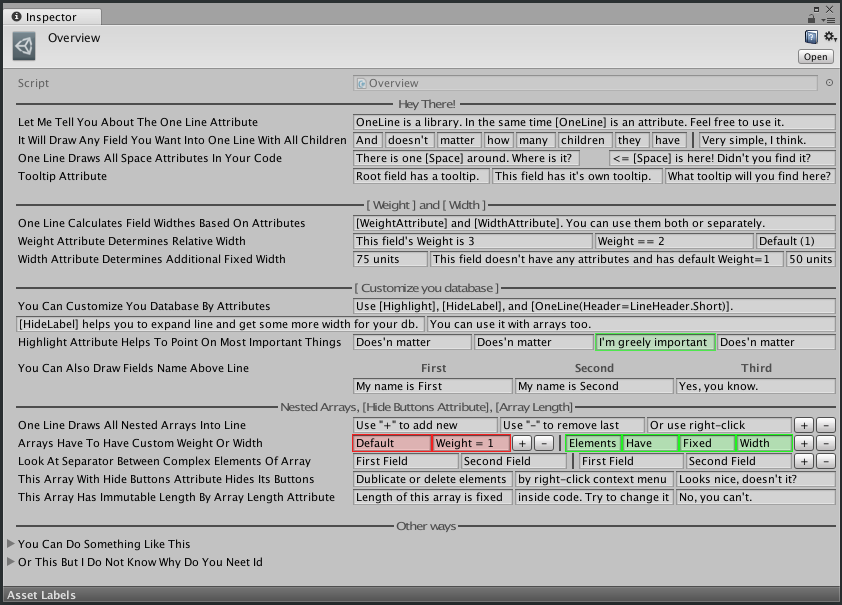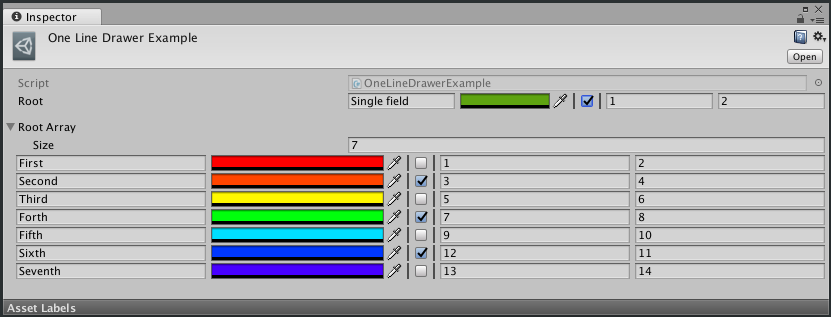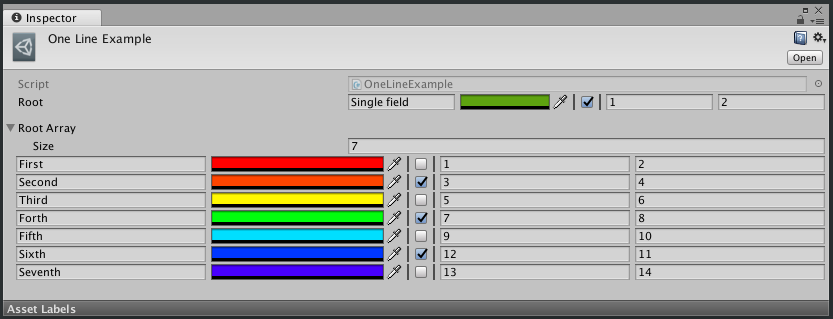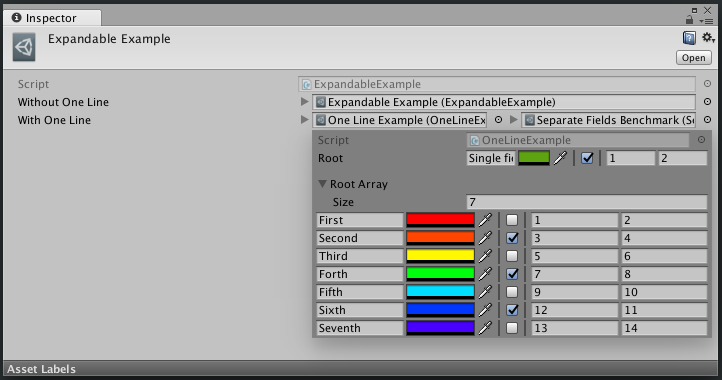OneLine provides a simple way to organize your databases without writing dozens of boilerplate code. It draws objects in Inspector into one line instead default line-by-line style. Also it provides a few features like field highlightning, locking array size, etc...
Read about OneLine on habr: 1, 2 (ru).
- 2019.01.15: v0.4.0 released!
- 2018.03.01: v0.3.0 released!
- 2018.02.27: Added
[Expandable]attribute. See description below and #22 - 2018.02.26: Added custom property drawers support.
Now any custom drawer, which returns height < 20, is drown. Acceptable for custom drawers of either types or attributes. - 2018.02.18: Available on the Asset Store for free.
- After importing look at
Assets/OneLine/Example/Overview/Overview.assetand open it in InspectorWindow. It'll show you all capabilities of the library; - In your code, add
using OneLine;and[OneLine]to fields you want to draw into one line. Note that internal fields don't need[OneLine]: they are processed automatically; - IToo customize onelined fields, use Width, Weight, HideLabel, Highlight, HideButtons and ArrayLength attributes (see Example.asset);
- Use Separator attribute to separate different fields;
- Use Expandable attribute to follow object references (real street magic is here) (idea is stolen from here;
- OneLine uses RectEx, so feel free to try it.
- Compatible with either .Net 2.0 or .Net 4.5 backends.
Table of contents:
- One Line Property Drawer
- One Line Attribute
- Customization with attributes:
- Separator Attribute
- Expandable Attribute
OneLinePropertyDrawer is a custom property drawer. It draws any property into a single line. To nicely draw your custom data class into one line, just extend OneLinePropertyDrawer.
Example:
// ./Example.cs
using System;
using UnityEngine;
using OneLine;
[CreateAssetMenu(menuName = "OneLine/OneLineDrawerExample")]
public class OneLineDrawerExample : ScriptableObject {
[SerializeField]
private RootField root;
[Space]
[SerializeField, HideLabel]
private RootField[] rootArray;
[Serializable]
public class RootField {
[SerializeField]
private string first;
[SerializeField]
private Color second;
[SerializeField]
private NestedField third;
}
[Serializable]
public class NestedField {
[SerializeField, Tooltip("This tooltip is very useful")]
private bool first;
[SerializeField]
private Vector2 second;
}
}
// ./Editor/ThreeFieldsDrawer.cs
using UnityEditor;
using OneLine;
[CustomPropertyDrawer(typeof(OneLineDrawerExample.RootField))]
public class OneLineDrawerExampleEditor : OneLinePropertyDrawer {
}Result:
You can also override protected property Header and return LineHeader.Short to add a table-like header. I wanted to add an example with headers but I didn't.
It's not nice to write additional classes for every data class. There is a couple of attributes created to make your life better.
[OneLine] is the core of all library. Add it to any field drawn in Inspector and it's view will be chanded: with all children it will be drawn into one line (and arrays with all elements and their children). It works completely recursive and automatic. You don't need to add [OneLine] to every field -- just to root. [OneLine] uses all other attributes to customize view. But other attributes is just markers and containers for settings (for example, [Weight] tells to [OneLine] that this field must me wery long, but it is not draws anything be itself). Except [Separator]: it is used as marker and as drawer depends on context.
Example:
using System;
using UnityEngine;
using OneLine;
[CreateAssetMenu(menuName = "OneLine/OneLineExample")]
public class OneLineExample : ScriptableObject {
[SerializeField, OneLine]
private RootField root;
[Space]
[SerializeField, OneLine, HideLabel]
private RootField[] rootArray;
[Serializable]
public class RootField {
[SerializeField]
private string first;
[SerializeField]
private Color second;
[SerializeField]
private NestedField third;
}
[Serializable]
public class NestedField {
[SerializeField, Tooltip("This tooltip is very useful")]
private bool first;
[SerializeField]
private Vector2 second;
}
}Result:
You can add [OneLine(Header = LineHeader.Short)] to add table-like header (see above).
[Weight] allows you to manage relative sizes of fields. For example, if class contains two fields: short integer ID and long string UUID, you can use [Weight] to set UUIDs length equals 8 IDs lenghtes. Added to array, specifies weight of every array element.
Note that values of [Width] and [Weight] are summarized: you cat set weight=2 and width=25 and field will be as two simple fields plus 25.
Note that attributes [Width] and [Weight] doesn't work with complex fields.
Example:
using System;
using UnityEngine;
using OneLine;
[CreateAssetMenu(menuName = "OneLine/WeightExample")]
public class WeightExample : ScriptableObject {
[SerializeField, OneLine]
private RootField root;
[Serializable]
public class RootField {
[SerializeField, Weight(3)]
private int first;
[SerializeField, Weight(2)]
private int second;
[SerializeField] // by default weight == 1
private int third;
[SerializeField, Weight(100)] // Does not work with complex fields
private ComplexField forth;
}
[Serializable]
public class ComplexField {
[SerializeField]
private int first;
}
}Result:
[Width] is same as [Weight] but operates with fixed widthes. It allows you to set fields width to 50. It uses GUI units (like all property drawers). It set Weight of field to 0 (zero), but you can change it with [Weight]. Added to array, specifies width of every array element.
Note that values of [Width] and [Weight] are summarized: you cat set weight=2 and width=25 and field will be as two simple fields plus 25.
Note that attributes [Width] and [Weight] doesn't work with complex fields.
Example:
using System;
using UnityEngine;
using OneLine;
[CreateAssetMenu(menuName = "OneLine/WidthExample")]
public class WidthExample : ScriptableObject {
[SerializeField, OneLine]
private RootField root;
[Serializable]
public class RootField {
[SerializeField, Width(70)]
private string first;
[SerializeField] // by default width = 0
private string second;
[SerializeField, Weight(2), Width(25)]
private string third;
[SerializeField, Width(10000000)] // Does not work with complex fields
private ComplexField forth;
}
[Serializable]
public class ComplexField {
[SerializeField]
private string first;
}
}Result:
[HideLabel] allows you to hide prefix label in view. It is useful to prevent width looses and draw your data in whole line. It works only with root fields (with nested fields labels aren't drawn). Added to array, hides labels of every array element.
Example:
using System;
using UnityEngine;
using OneLine;
[CreateAssetMenu(menuName = "OneLine/HideLabelExample")]
public class HideLabelExample : ScriptableObject {
[SerializeField, OneLine, HideLabel]
private ThreeFields thisSelfDocumentedFieldNameWillNotBeShownInTheInspector;
[Serializable]
public class ThreeFields {
[SerializeField]
private string first;
[SerializeField]
private string second;
[SerializeField]
private string third;
}
}Result:
[Highlight] allows you to highlight field with some color (r, g, b). C sharp doesn't allow to pass custom classes or struct to attributes, sou you need to pass three float in [0..1]. If you add [Highlight] to root field, it highlightes its prefix label too; if you add [Highlight] to nested field, it also highlights. Even in arrays.
Example:
using System;
using UnityEngine;
using OneLine;
[CreateAssetMenu(menuName = "OneLine/HighlightExample")]
public class HighlightExample : ScriptableObject {
[SerializeField, OneLine, Highlight]
private string rootField;
[SerializeField, OneLine]
private HighlightedFields nestedFields;
[Serializable]
public class HighlightedFields {
[SerializeField, Highlight(0, 1, 0)]
private string first;
[SerializeField, Highlight(0, 0, 1)]
private string second;
[SerializeField]
private string third;
[SerializeField, Highlight(1, 1, 0)]
private string fourth;
}
}Result:
If you add [OneLine] to field, which contains arrays in children, arrays of this elements will be linified. But if you add [OneLine] to array, instead drawing whole array into one line, it will draw array line-by-line (as usial), but every element will be drawn into one line.
Example:
using System;
using UnityEngine;
using OneLine;
[CreateAssetMenu(menuName = "OneLine/RootArrayExample")]
public class RootArrayExample : ScriptableObject {
[SerializeField, OneLine]
private RootField[] rootArray;
[Space]
[SerializeField, OneLine]
private SingleArray singleNestedArray;
[SerializeField, OneLine]
private TwoArrays twoNestedArrays;
[Serializable]
public class RootField {
[SerializeField]
private string first;
[SerializeField]
private string second;
[SerializeField]
private string third;
}
[Serializable]
public class SingleArray {
[SerializeField]
private string[] array;
}
[Serializable]
public class TwoArrays {
[SerializeField, Highlight(1, 0, 0)]
private int[] first;
[SerializeField, Highlight(0, 1, 0), Width(125)]
private string[] second;
}
}Result:
[HideButtons] hides buttons + and - from array. It allow you to increase useful space. You may change array size with Right-click drop-down menu. When array contains 0 (zero) elements, button + appears, when you click it, buttons dissapears.
[HideButtons] works only with nested arrays.
Example:
using System;
using UnityEngine;
using OneLine;
[CreateAssetMenu(menuName = "OneLine/HideButtonsExample")]
public class HideButtonsExample : ScriptableObject {
[SerializeField, OneLine]
private ArrayHidesButtons arrayWithElements;
[SerializeField, OneLine]
private ArrayHidesButtons zeroLengthArray;
[Serializable]
public class ArrayHidesButtons {
[SerializeField, HideButtons]
private string[] array;
}
}Result:
Specifies fixed lenth of array. Useful for need to set up fixed number of integers and you don't want to create a lot of hardcoded fields or you need to iterate them at runtime (it is not nice to iterate fields).
[FixedLength] works only with nested arrays.
Example:
using System;
using UnityEngine;
using OneLine;
[CreateAssetMenu(menuName = "OneLine/FixedLengthExample")]
public class FixedLengthExample : ScriptableObject {
[SerializeField, OneLine]
private ImmutableLengthArray arrayWithImmutableLength;
[Serializable]
public class ImmutableLengthArray {
[SerializeField, ArrayLength(7)]
private string[] array;
}
}Result:
[Separator] allows you to separate fields from each other (like [Space] but better). Added to root field, draws a horizontal line with label. Added to nested field, draws a vertical line inside line.
Example:
using System;
using UnityEngine;
using OneLine;
[CreateAssetMenu(menuName = "OneLine/SeparatorExample")]
public class SeparatorExample : ScriptableObject {
[SerializeField, OneLine]
private TwoFields first;
[Space]
[SerializeField, Separator("[ Separator separates ]"), OneLine]
private TwoFields second;
[Serializable]
public class TwoFields {
[SerializeField]
private string first;
[SerializeField, Separator]
private string second;
}
}Result:
[Expandable] allows you to follow object references without switching Inspector Window focus. Added to any object field (of type extends UnityEngine.Object), creates a foldout-like button near object field.
Use [ReadOnlyExpandable] to make opened popup readonly.
Known issues: #22
Due to Unity's bug, you can't edit expanded object with keyboard, only with mouse.
I don't know how to resolve this issue (direct forwarding keyboard events doesn't work) and I'm going to keep this as well.
If you really need resolving this issue, let me know at #22.
using System;
using UnityEngine;
using OneLine;
[CreateAssetMenu(menuName = "OneLine/ExpandableExample")]
public class ExpandableExample : ScriptableObject {
[SerializeField, Expandable]
private UnityEngine.Object withoutOneLine;
[SerializeField, OneLine]
private TwoFields withOneLine;
[Serializable]
public class TwoFields {
[SerializeField, Expandable]
private ScriptableObject first;
[SerializeField, Expandable]
private UnityEngine.Object second;
}
}















